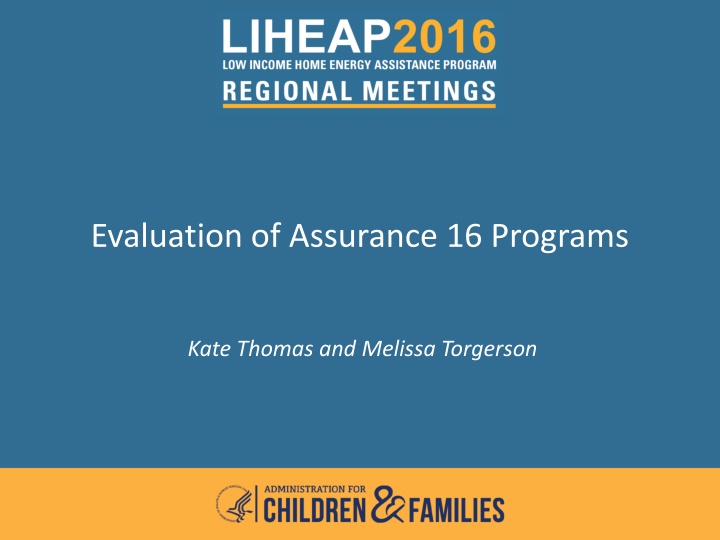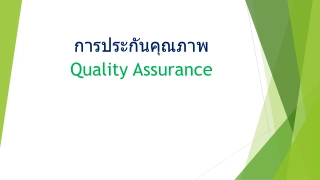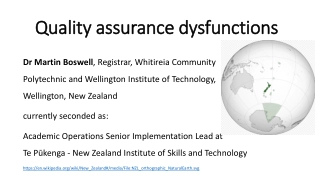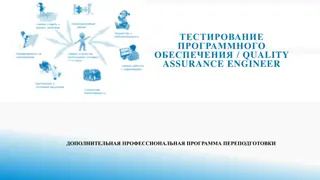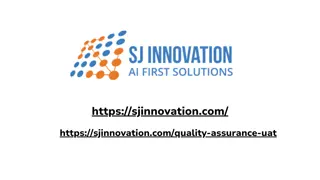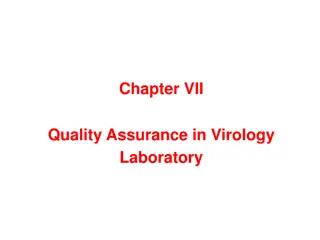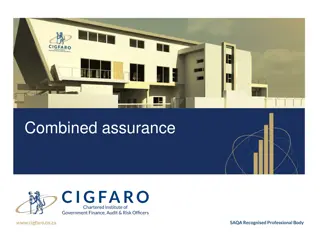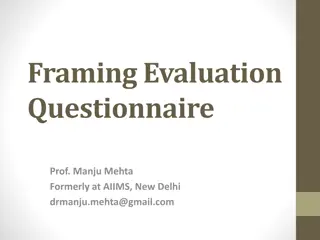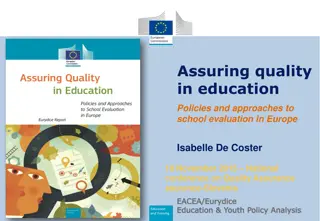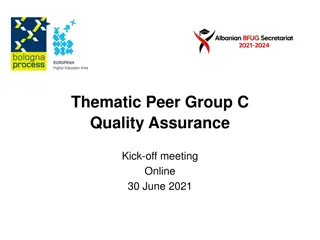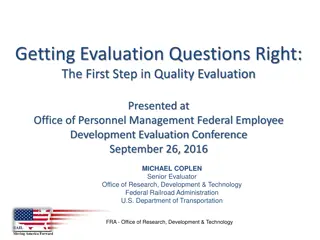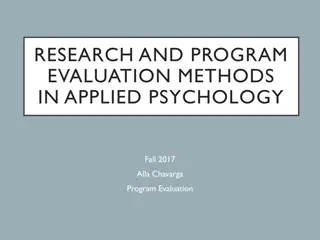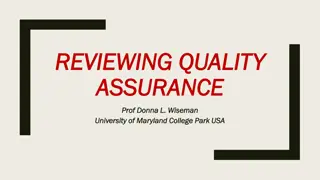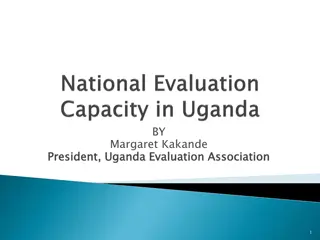Evaluation of Assurance 16 Programs
This document explores Assurance 16 programs introduced in the LIHEAP statute, detailing allowable expenditures, examples of activities, funding allocation, and reporting requirements. It provides insights into how grantees can utilize funds to assist households in reducing energy needs and provides a snapshot of states, tribes, and territories investing in Assurance 16 activities.
Download Presentation

Please find below an Image/Link to download the presentation.
The content on the website is provided AS IS for your information and personal use only. It may not be sold, licensed, or shared on other websites without obtaining consent from the author.If you encounter any issues during the download, it is possible that the publisher has removed the file from their server.
You are allowed to download the files provided on this website for personal or commercial use, subject to the condition that they are used lawfully. All files are the property of their respective owners.
The content on the website is provided AS IS for your information and personal use only. It may not be sold, licensed, or shared on other websites without obtaining consent from the author.
E N D
Presentation Transcript
Evaluation of Assurance 16 Programs Kate Thomas and Melissa Torgerson
Agenda Understanding Assurance 16 Evaluating Assurance 16 Questions and Answers 2
Understanding Assurance 16 Assurance 16 was added to the LIHEAP statute as part of the 1994 program re-authorization. Assurance 16 allows grantees to use up to 5 percent of such funds to provide services that encourage and enable households to reduce their home energy needs and thereby the need for energy assistance There are no additional administrative funds associated with Assurance 16. 4
Understanding Assurance 16 Allowable expenditures under Assurance 16 ... services that encourage and enable households to reduce their home energy needs {services not equipment} including needs assessments, counseling, and assistance with [working with] energy vendors Outreach and other normal program operations costs are not allowable Assurance 16 activities. 5
Understanding Assurance 16 Examples of Assurance 16 Activities Case Management Energy Education and Advocacy Financial Counseling Vendor Advocacy and Negotiations Crisis Interventions Referrals Needs Assessments 0 5 10 15 20 25 30 35 States 6
Understanding Assurance 16 34 states, 28 tribes and 2 territories are spending LIHEAP funds on Assurance 16 activities in FY 2016 In FY 2014, over $40 million was obligated for Assurance 16 activities by states 7
Understanding Assurance 16 The LIHEAP statute requires that grantees: report to the Secretary concerning the impact of such activities on the number of households served, the level of direct benefits provided to those households, and the number that remain unserved. This is operationalized in the Detailed Model Plan in Section 13. 13.1: Description of A16 services 13.2: Limitation of spending on A16 services to 5 percent of funds 13.3: Description of the impact of A16 services on the number of households served 13.4: Description of the direct benefit provided to households 13.5/13.6: Number of applicants and number of recipients 8
Evaluating Assurance 16 Why should I evaluate my Assurance 16 program? 25 grantees reported spending over $40 million in FY 2014. At an average benefit of $500 per household, the program could have served 80,000 more households if there were no spending on Assurance 16. 11 grantees reported spending over $1 million in FY 2014. At an average benefit of $500 per household, each of those programs could have served at least 2,000 more households if there were no spending on Assurance 16. If a grantee is going to spend a substantial amount of funding on A16 activities, they should have some confidence that the program is making a difference. 10
Evaluating Assurance 16 How can I evaluate my Assurance 16 program? Logic Model: Work with your subgrantees to document the following What problem are you trying to solve? What resources are you going to use? What services are you going to deliver? What change do you expect to effect? What impact do you expect that to have on the client? What impact do you expect that to have on the need for LIHEAP assistance? Data Tracking System: Set up a data tracking system that allows you to see who was served and what services they received, and that allows you to conduct follow-up research to measure program impacts. 11
Evaluating Assurance 16 How can I evaluate my Assurance 16 program? (continued) Process Evaluation: Collect information that helps you to understand whether the program appears to be working as planned. Impact Evaluation: Collect information that helps you to document what impact the program has on households needs for energy assistance. Performance Management: Incorporate what you learn into your LIHEAP Performance Management plan to maximize the impact of the overall LIHEAP program by making use of A16 services. 12
EVALUATING ASSURANCE 16 LOGIC MODEL 13
Evaluating Assurance 16 Logic Model Logic Model Basics Problem Statement: Clearly state the problem that you are trying to solve. {e.g. Client uses check cashing service.} Strategy: Identify the specific service that is going to be applied and how it should help to resolve the problem. {e.g., Help client to access free checking services available to low-income fixed income.} Outputs: Describe how you will document that the service was delivered to the clients in need. {e.g., Helped 100 clients complete the free checking account application.} 14
Evaluating Assurance 16 Logic Model Logic Model Basics (continued) Short-Term Outcomes: Document changes that are directly observable {e.g., 95 of 100 clients got free checking accounts.} Intermediate-Term Outcomes: Document changes that occur over a longer time period {e.g., Six months later 50 of 100 clients paid energy bills and other bills with free checks instead of money orders.} Impacts: Measure the impacts of the program over times. {e.g., Clients who got the service saved an average of $100 per year and had 5 percent lower shutoff rate than clients who did not get the service.} 15
Evaluating Assurance 16 Logic Model In-Home Energy Education Program Example of Logic Model Operationalized Problem Statement: Clients have high electric energy bills throughout the year, are accruing arrearages, and need crisis benefits when electric shutoff restrictions end. Strategy: Conduct on-site energy education visit to identify the energy practices and equipment that cause high usage. Prioritize behavior changes that will have the greatest impact. Connect the client to utility programs that will furnish lighting and appliance replacements at no charge. Outputs: Scheduled 125 on-site visits. Completed 105 on-site visits. Got behavioral change commitments from 102 clients. Identified available utility programs for 82 clients. 16
Evaluating Assurance 16 Logic Model In-Home Energy Education Program Example of Logic Model Operationalized (continued) Short-Term Outcomes: Follow-up surveys found that 75 of 102 clients who made commitments are keeping the commitments. 62 clients received low- cost measures from the utility company (e.g., light bulbs and showerheads). 22 clients received major appliances (e.g., refrigerators and clothes washers). 12 clients received utility weatherization services. Intermediate-Term Outcomes: One year later, obtained energy bills for 70 participating clients and found that average gas usage declined by 5% (20% for weatherization services) and average electric usage declined by 7% (15% for appliances). Impacts: Only 25% of clients who got service used Crisis Assistance in the next program year, while 75% of clients who did not get service used Crisis Assistance in the next program year. 17
EVALUATING ASSURANCE 16 DATA TRACKING SYSTEM 18
Evaluating Assurance 16 Data Tracking System Data Tracking System What information do I need? Demographics: Record the key information about this household, including income, household size, and vulnerability status for individuals. Baseline Status: Document the baseline status for the individual to document their need for the service. Service Delivery: What service did they get? When did they get it? Who delivered it? Program Outputs: Make sure that you input all immediate outputs of the service. Applications completed. Client commitments. Appointments scheduled. Program Outcomes: Set up a place to record program outcomes, even if you might not be able to record those outcomes for all clients. 19
Evaluating Assurance 16 Data Tracking System Data Tracking System Integrated System: For a large-scale ongoing A16 program, build the A16 data tracking into your client database. Targeting: Allows you to use LIHEAP intake and benefit information on clients to target services to appropriate clients. Example: Target financial counseling to clients who use Crisis benefits two years in a row. Analysis: All of the data is in one place, making it easier to look at differential program impacts by client characteristics and status. Reporting: Integrates A16 reporting into the systems from which other grantee reports are developed. 20
Evaluating Assurance 16 Data Tracking System Data Tracking System Stand-Alone System: For pilot programs, or for grantees who encourage each sub-grantee to develop their own program that takes advantage of local resources. Flexibility: Allows each subgrantee to specify the information their system will track. Template: Be sure to set up a data tracking system template so that all share common design features to increase consistency and reduce set up and maintenance costs. Connections: Make sure that the systems can import data from your client database and can export data to your LIHEAP reporting system. 21
Evaluating Assurance 16 Data Tracking System Example #1 A16 Data Tracking System Cover Screen: 22
Evaluating Assurance 16 Data Tracking System Example #2 A16 Data Tracking System Client Summary Page: 23
Evaluating Assurance 16 Data Tracking System Example #3 A16 Data Tracking System Client Data Entry Page: 24
EVALUATING ASSURANCE 16 PROCESS EVALUATION 25
Evaluating Assurance 16 Process Evaluation Process Evaluation {You can do this!} Program Statistics: Use the Data Tracking System to compare program design to program implementation. Targeting: What types of clients were target by the program? Is that who received the services? Program Inputs: What level of investment was expected per client? What is the actual level of investment? Program Outputs: How do program outputs compare to expectations? 26
Evaluating Assurance 16 Process Evaluation Process Evaluation {You can do this!} Administrative In-Depth Interviews: Conduct in-depth interviews with organization director, program manager, and program staff. Program Statistics: Share the program statistics. {Beginning ,not end, of discussion.} Program Successes: Ask them to tell you what is working and how they know. Program Barriers: Encourage them to tell you what is not working and how they know. Program Recommendations: Ask them to make recommendations for program changes and to prioritize those recommendations. 27
Evaluating Assurance 16 Process Evaluation (continued) Process Evaluation {You can do this!} Observations: There is no substitute for directly observing service delivery. Observer: You need to be a silent observer who legitimately is characterized as learning about the program. Service Provider Debrief: Ask the service provider to report on what worked, what did not work, and whether that was a typical service interaction. Client Debrief: Ask the client to tell you about their experiences. You ll sometimes be surprised by what you hear, since it won t always be the same as what you saw. 28
Evaluating Assurance 16 Process Evaluation (continued) Process Evaluation {You can do this!} Client In-Depth Interviews: Once you understand how the program works, conduct in-depth interviews with clients. Program Successes: Ask them to tell you what they perceived were the benefits of program participation. Program Barriers: Encourage them to tell you what they expected, what they did not get, and how the program could be improved for them. 29
Evaluating Assurance 16 Process Evaluation (continued) Process Evaluation {You can do this!} Process Evaluation DOs and DO NOTs DO Ask program managers, staff, and clients for a clear explanation of why they think that the program is succeeding and/or failing to meet their expectations. Dig deep!! DO Make sure that you systematically document your findings so that you are not overly influenced by your first or last experiences. DO Be prepared to learn things that you did not expect about how the program and service delivery staff are perceived and understood. DO NOT Lead the discussion to a pre-determined outcome. Stay neutral and try to ask questions in the same way for the first and last interviews. DO NOT Overreact to the experiences and/or perceptions of one individual. Powerfully-held opinions are not always widely-held opinions. 30
EVALUATING ASSURANCE 16 IMPACT EVALUATION 31
Evaluating Assurance 16 Impact Evaluation Impact Evaluation {You can do at least part of this!} Program Statistics: Based on findings from Process Evaluation, use the Data Tracking System to develop updated statistics that compare program design to program implementation. Targeting: Who is served by the program and how does that compare to plans? Program Inputs: What is the investment per client and how does that compare to plans? Program Outputs: What are program outputs that are documented in the Data Tracking system? Are there any other outputs that can be documented from existing data? 32
Evaluating Assurance 16 Impact Evaluation Impact Evaluation {You can do at least part of this!} Client Surveys: Conduct quantitative surveys with clients to measure certain program outcomes. Understanding: Measure whether the client understood the services that were delivered. Behavior Changes: Assess which behavior changes clients made and whether they perceive them to be effective. Program Follow-Up: Quantify the share of clients who received services to which they were referred (e.g., packages of low cost measures, free checking account). Client Perceptions: Ask clients to tell you about changes in their status that might be correlated with program services. 33
Evaluating Assurance 16 Impact Evaluation (continued) Impact Evaluation {You can do at least part of this!!!} Quantitative Measures: This is the likely to be the most challenging task for an impact evaluation. The quantitative data you collect will need to be tailored to the expected program outcomes. Energy Usage: Are you targeting energy education? You will need to collect pre/post data from the energy vendors. Bill Payment: Are you targeting improved payment behavior? You will need to collect pre/post transactions data from the energy vendors. Referrals: Are you trying to make sure that the clients increased available income? You will need to develop follow-up procedures that track program participation and employment status? 34
Evaluating Assurance 16 Impact Evaluation (continued) Impact Evaluation {You can do at least part of this!!!} Program Measures: To some extent, you can use longitudinal program statistics to measure program outcomes. Crisis Program: Look at the use of the crisis program. Were several years of crisis program participation prior to program intervention followed by one or more years without crisis benefits? Benefit Levels: If your benefits are based on the energy bills and income, did benefits for participating households fall as they used less energy and/or got more income? Program Participation: Is there any way to document that clients are still living in the area, but no longer need LIHEAP program services? 35
Evaluating Assurance 16 Impact Evaluation (continued) Impact Evaluation {You can do at least part of this!!!} Impact Evaluation DOs and DO NOTs DO Make sure that you start with reliable program statistics. DO Respect your clients by using good survey research procedures (advance letters, phone messages, short interviews that get to the point). DO Work with your program partners to retrieve and interpret data. DO NOT Present findings that come from biased research methods or that use deemed program outcomes. No information is better than biased information. DO NOT Characterize program outcomes as program impacts UNLESS you have designed and implemented experimental or quasi-experimental research procedures. 36
Evaluating Assurance 16 Impact Evaluation (continued) Impact Evaluation {You can do at least part of this!!!} Gross Program Impacts: You measure gross program impacts by looking at the client s status prior to program intervention and comparing it to the client s status after program intervention. Analysis Period It is important to define an appropriate analysis period. For energy usage, bill payment, and income statistics are usually examined over at least a one-year period. And, efforts are made to normalize between the pre- and post-program periods. {Was it really cold in the year prior to participation and really warm in the next year?} 37
Evaluating Assurance 16 Impact Evaluation (continued) Impact Evaluation {You can do at least part of this!!!} Net Program Impacts: You measure net program impacts by comparing the outcomes for the clients who received services to comparable clients who did not receive services. Unexpected Outcomes Sometimes, we find that it appears that a program had no outcome, when, in fact, the client would have been worse off in the absence of the program.{Think about 2008.} 38
EVALUATING ASSURANCE 16 INTEGRATION WITH PERFORMANCE MANAGEMENT 39
Integrate Performance Management Findings into Assurance 16 Program Design Examples Analysis of Benefits: 25% of clients get both regular and crisis benefits for at least three of the last five years. Assurance 16 Program: Implement an Assurance 16 program that targets those clients for needs assessment and referral. High Energy Bills: 10% of clients have energy bills that are more than 2X the average for all clients. Even with higher LIHEAP grants, those clients have net home energy burden over 20% of income. Assurance 16 Program: Target clients for on-site energy needs assessment. Determine whether problems related to client behaviors, inefficient energy equipment, or leaky and poorly insulated home. 40
Integrate Performance Management Findings into Assurance 16 Program Design Examples (continued) Repeated Disconnections: 15% of clients needed to have service restored in three of the last five years. Assurance 16 Program: Conduct outreach to energy vendors to develop procedures to avoid service disconnections for clients that are long-term program participants (e.g., fixed income elderly and/or disabled). 41
Integrate Assurance 16 Evaluation Findings into Performance Management Examples A16 Needs Assessment Program: A16 program evaluation finds that clients have sufficient resources but poor financial management skills. Performance Management: Consider changes to the benefit payment system to spread LIHEAP grant over time. A16 High Energy Bills Program: A16 program evaluation finds that unsafe equipment is a barrier to leveraging utility funds for weatherization. Performance Management: Consider implementing heating and cooling equipment repair and replacement program. 42
Integrate Assurance 16 Evaluation Findings into Performance Management Examples (continued) A16 Vendor Advocacy Program: A16 program evaluation finds that current benefits for some elderly and disabled are not sufficient to make energy bills affordable and prevent shutoff. Performance Management: Consider modifying the benefit matrix to better target benefits to clients with the highest burden. 43
Resources Minnesota Minnesota A16 and Outreach Activities Report at http://liheap.ncat.org/pubs/LCIssueBriefs/A16/A16andOutreachActivitiesRep ort.docx Minnesota 2014 Energy Assistance Program Manual(A16) at http://liheap.ncat.org/pubs/LCIssueBriefs/A16/MN_A16_manual2014.pdf Form for Minnesota Report on A16 Activities at http://liheap.ncat.org/pubs/LCIssueBriefs/A16/MN_A16_Report.docx 44
Resources Delaware Memorandum of Understanding at http://liheap.ncat.org/pubs/LCIssueBriefs/A16/DE_MOU_SOV_OCS.docx Indiana Presentation about Indiana A16 and Leveraging at http://liheap.ncat.org/pubs/LCIssueBriefs/INA16presentation.pdf Indiana REACH Evaluation Summary at http://liheap.ncat.org/pubs/LCIssueBriefs/A16/Indiana_REACH_eval.docx 45
Resources LIHEAP IM 2000-12 Cost for Planning and Administration http://www.acf.hhs.gov/programs/ocs/resource/liheap-im-on-costs-for-planning- and-administration-updated-information LIHEAP Clearinghouse Issue Brief: LIHEAP Administrative Cost Savings http://www.liheapch.acf.hhs.gov/docs/Admincosts.pdf 46
The next session is... STATE TRACK: GRANTEE EXPERIENCES WITH DELIVERED FUEL VENDORS OR TRIBAL TRACK: WORKING WITH DELIVERABLE FUEL VENDORS 48
